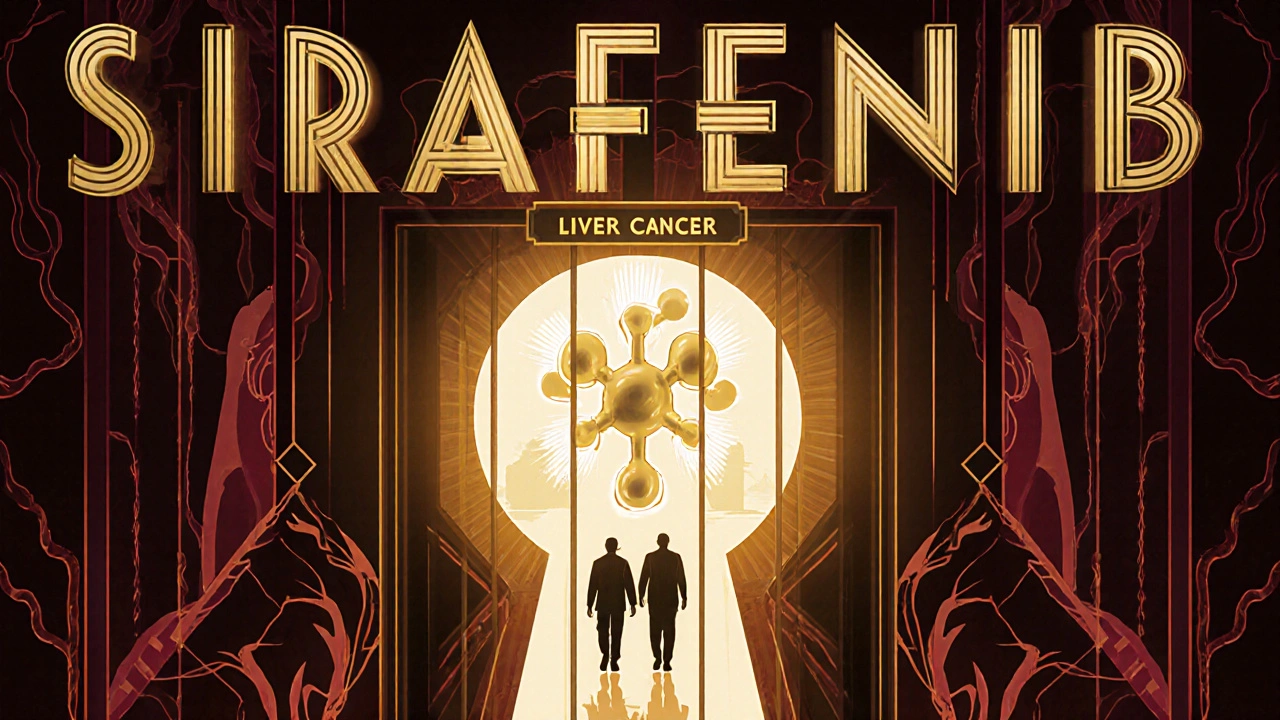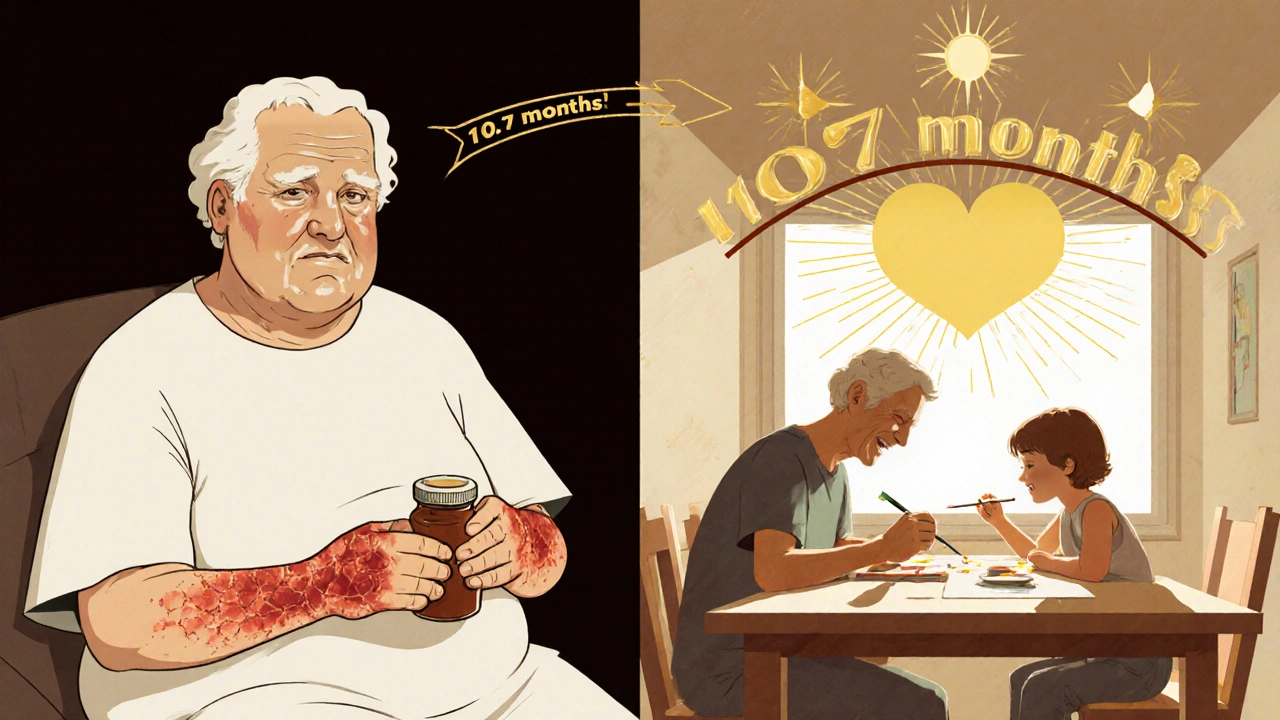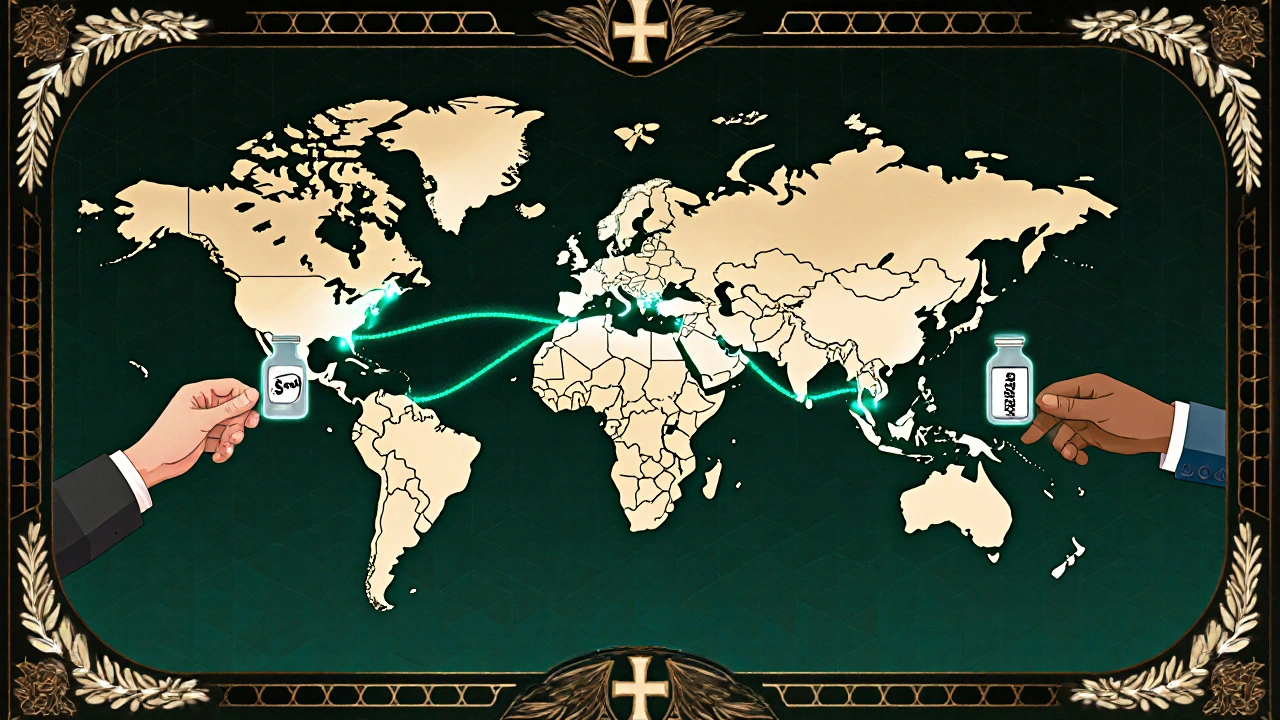The Challenges and Successes of Sorafenib Clinical Trials
 Oct, 28 2025
Oct, 28 2025
Sorafenib changed the game for patients with advanced liver and kidney cancer-but getting there wasn’t easy. Before sorafenib, there were almost no effective treatments for these cancers once they spread. Doctors had little to offer beyond palliative care. Then came the clinical trials that proved sorafenib could extend life, sometimes by months, sometimes by years. But the road to approval was paved with setbacks, unexpected side effects, and tough questions about who truly benefited.
What sorafenib is and how it works
Sorafenib is a small molecule kinase inhibitor. It blocks several proteins that cancer cells use to grow and spread, including VEGFR, PDGFR, and RAF. By shutting down these signals, it starves tumors of blood vessels and slows their ability to divide. Unlike chemotherapy, which attacks all fast-growing cells, sorafenib targets specific pathways cancer cells depend on. This made it one of the first true targeted therapies approved for solid tumors.
In 2005, the FDA granted sorafenib breakthrough designation after early trials showed it could stabilize disease in patients with advanced hepatocellular carcinoma (HCC), the most common form of liver cancer. Before that, median survival for these patients was less than six months. Sorafenib pushed that to about 10.7 months in the largest trial. It wasn’t a cure, but it was a lifeline.
The SHARP trial: the breakthrough that changed everything
The SHARP trial, published in 2007, was the turning point. It was a double-blind, placebo-controlled study involving 602 patients with advanced liver cancer who hadn’t responded to other treatments. Half got sorafenib; half got a dummy pill. The results were clear: patients on sorafenib lived 44% longer than those on placebo. Tumor shrinkage was rare, but disease progression slowed significantly.
What made SHARP stand out wasn’t just the numbers-it was the rigor. The trial used standardized imaging, strict eligibility criteria, and real-world endpoints like overall survival, not just tumor size. It proved sorafenib wasn’t just a lab curiosity. It worked in actual patients, in real hospitals, with real complications.
By 2008, the FDA and EMA approved sorafenib for liver cancer. It was the first systemic therapy approved for HCC in over a decade. For many patients, it became the new standard of care.
The kidney cancer trial: a second win
Even before liver cancer, sorafenib showed promise in renal cell carcinoma (RCC), the most common type of kidney cancer. The TARGET trial, completed in 2007, tested sorafenib in 903 patients with advanced RCC who had failed prior treatments. The results mirrored SHARP: sorafenib nearly doubled the time patients lived without their cancer worsening-from 5.5 months to 5.5 months? No-wait, it doubled it to 5.5 months from 2.8 months. That’s a 100% improvement in progression-free survival.
While overall survival didn’t improve as dramatically (a common issue with targeted therapies), the fact that patients stayed stable longer meant fewer hospital visits, less pain, and more time with family. For many, that was worth the side effects.

The side effects no one talked about
But sorafenib came with a price. Almost every patient experienced some level of fatigue, hand-foot skin reaction (HFSR), diarrhea, or high blood pressure. HFSR was the most visible: red, peeling, blistered palms and soles that made walking painful. Some patients had to reduce their dose or stop treatment entirely.
Doctors weren’t prepared. Many didn’t know how to manage HFSR. Patients showed up with cracked skin, bleeding, and infections. One study found that nearly 30% of patients needed dose reductions because of skin toxicity. Others developed severe hypertension-sometimes requiring multiple medications just to keep blood pressure under control.
Worse, some patients didn’t respond at all. About 40% of liver cancer patients saw no benefit. Why? Researchers later found that mutations in certain genes, like KRAS or BRAF, could make tumors resistant to sorafenib. But testing for these mutations wasn’t routine. So many patients suffered side effects for nothing.
Real-world struggles: when trials don’t tell the whole story
Clinical trials are controlled. Real life isn’t. In trials, patients are carefully selected: they’re relatively healthy, have good organ function, and are closely monitored. In clinics, many patients are older, have cirrhosis, diabetes, or other conditions. They might not take their pills regularly. They might skip follow-up scans.
A 2014 study from Germany tracked 1,200 real-world liver cancer patients on sorafenib. Only 58% stayed on the full dose for more than three months. Many stopped because of side effects, not because the drug stopped working. Others couldn’t afford it. In countries without universal healthcare, sorafenib cost over $10,000 a month. That’s more than most people earn in a year.
Even in wealthy countries, insurance companies often denied coverage unless patients met strict criteria. Some required proof of tumor progression on prior treatment. Others demanded genetic testing that wasn’t widely available. So many patients were stuck in bureaucratic limbo while their cancer advanced.

Successes beyond survival: quality of life and hope
Despite the challenges, sorafenib gave patients something no other drug had: time. Not just more months on the clock, but more days where they could sit with their grandchildren, travel to see family, or simply wake up without nausea.
One patient from Ohio, diagnosed with stage IV liver cancer in 2010, lived for 31 months on sorafenib. She never had a tumor shrink, but her liver function stayed stable. She painted, taught her granddaughter to bake, and went to her daughter’s wedding. Her oncologist said she was one of the longest-surviving patients in his practice. She didn’t beat cancer-but she lived with it longer than anyone expected.
For many, sorafenib became a bridge. It kept them alive long enough to enroll in newer trials-for drugs like lenvatinib, regorafenib, or immunotherapy combinations. Without sorafenib, many wouldn’t have lived to see those options.
Where sorafenib stands today
Today, sorafenib is no longer the first-line treatment for liver or kidney cancer. Newer drugs like lenvatinib, pembrolizumab, and nivolumab have taken its place in many guidelines. But it’s still used-especially in low-resource settings where newer drugs are too expensive or unavailable.
In India, Egypt, and parts of Eastern Europe, sorafenib remains the most accessible targeted therapy. Generic versions now cost under $300 a month. That’s a fraction of the original price. For many patients, it’s the only option.
Researchers are still studying it. New trials are testing sorafenib in combination with immunotherapies, or as a maintenance therapy after surgery. Early results suggest it might help prevent recurrence in some liver cancer patients.
Lessons learned from sorafenib
Sorafenib’s story isn’t just about one drug. It’s about how cancer treatment evolved. It showed that targeted therapy could work, even if imperfectly. It forced doctors to pay attention to side effects-not just survival. It exposed the gap between clinical trials and real-world care. And it proved that even small improvements in survival matter deeply to patients.
Today’s cancer drugs owe a lot to sorafenib. It wasn’t perfect. It wasn’t magic. But it was the first real step forward in decades. And for thousands of people, that step was everything.
Is sorafenib still used today?
Yes, sorafenib is still used, especially in regions where newer drugs are too expensive or unavailable. While it’s no longer the first choice for most patients in the U.S. or Europe, it remains a key treatment option in countries like India, Egypt, and parts of Eastern Europe. Generic versions have made it more affordable, and it’s sometimes used in combination with newer therapies in clinical trials.
What cancers is sorafenib approved for?
Sorafenib is approved for two main cancers: advanced hepatocellular carcinoma (HCC), which is the most common type of liver cancer, and advanced renal cell carcinoma (RCC), the most common type of kidney cancer. It was the first targeted therapy approved for both.
Why did some patients stop taking sorafenib?
Many patients stopped because of side effects like hand-foot skin reaction (HFSR), severe fatigue, high blood pressure, or diarrhea. In real-world use, nearly one in three patients needed a dose reduction or had to stop treatment entirely. Others couldn’t afford it, or their insurance denied coverage. Some patients simply didn’t respond to the drug at all.
Did sorafenib shrink tumors in most patients?
No, tumor shrinkage was rare. In clinical trials, only about 2% to 10% of patients saw their tumors shrink significantly. The main benefit wasn’t shrinking tumors-it was slowing their growth. Patients often lived longer because their cancer didn’t spread as quickly, even if the tumors didn’t get smaller.
How did sorafenib change cancer treatment?
Sorafenib proved that targeted therapy could extend survival in advanced solid tumors, even without dramatic tumor shrinkage. It opened the door for other kinase inhibitors and shifted the focus from chemotherapy to drugs that block specific cancer pathways. It also highlighted the importance of managing side effects and the gap between clinical trial results and real-world outcomes.
Rose Macaulay
October 29, 2025 AT 08:06I just cried reading about that Ohio woman who painted and baked with her granddaughter. That’s what this drug really gave people-not just time, but dignity.
Eben Neppie
October 29, 2025 AT 15:49Let’s be real-sorafenib wasn’t magic, but it was the first time oncologists had to actually talk to patients about quality of life instead of just pushing chemo. The side effects were brutal, but the fact that we started measuring survival in months instead of weeks? That’s the real legacy.
And don’t get me started on how the pharma companies priced it at $10K/month while patients bled out from HFSR. This drug exposed the moral rot in oncology economics.
It’s not about tumor shrinkage. It’s about whether someone gets to see their kid graduate. Sorafenib gave that to people. No other drug before it even tried.
The SHARP trial was the first time a cancer drug proved survival benefit without objective response. That changed everything. Now we have dozens of drugs built on that model.
And yes, the 40% non-responders? We still don’t have good biomarkers. But at least now we’re asking the right questions.
Milind Caspar
October 30, 2025 AT 08:49Do you realize that sorafenib was approved based on a 4.7-month survival gain? That’s less than half a year. Meanwhile, the pharmaceutical industry made billions. This is not medicine-it’s predatory capitalism disguised as science.
The so-called 'breakthrough' was a statistical mirage. Patients suffered excruciating skin reactions, hypertension, and diarrhea-all for a median extension of 142 days. And yet, we celebrate this as progress?
The real tragedy? Those who benefited were the lucky 60%. The rest? They were collateral damage in a profit-driven system that values metrics over human beings. This drug didn’t save lives-it extended suffering for the sake of FDA approval.
And now we’re told to be grateful? Look at India-where generics cost $300. That’s not innovation. That’s exploitation. The original price was a crime.
They didn’t cure cancer. They just found a way to monetize dying slower.
Prema Amrita
October 30, 2025 AT 22:44In Mumbai, my uncle took generic sorafenib for 18 months. No insurance. No subsidies. Paid out of pocket. His hands cracked, he couldn’t hold his chai, but he watched his granddaughter’s first steps.
Doctors here didn’t know how to manage HFSR. We used coconut oil and cotton socks. It wasn’t medical. It was love.
Sorafenib didn’t cure him. But it gave him the gift of presence. That’s more than any trial statistic can measure.
Today, newer drugs are here-but for millions, sorafenib is still the only bridge. Don’t call it outdated. Call it essential.
Steven Shu
October 31, 2025 AT 08:07Stop romanticizing this. Sorafenib was a Band-Aid on a gunshot wound. Yes, it extended life-but at what cost? Patients were walking around with bleeding palms, constant diarrhea, and blood pressure so high they needed three meds just to stay alive.
The trials were rigged with healthy patients. Real people? They couldn’t tolerate it. The 58% discontinuation rate in Germany? That’s not adherence-it’s survival instinct.
And don’t tell me about 'hope.' Hope doesn’t pay rent. Hope doesn’t cover groceries while you’re too tired to work. This drug was a financial death sentence for most.
We need better. Not more gratitude for broken systems.
Robert Burruss
November 2, 2025 AT 02:53It’s fascinating-sorafenib forced oncology to confront the philosophical paradox of survival: if you extend life, but not quality, are you healing-or just delaying the inevitable?
The drug didn’t cure, but it changed the narrative. We stopped measuring success by tumor size and started measuring it by presence-by laughter, by meals shared, by quiet mornings without pain.
Perhaps that’s the deeper revolution: it made us see that medicine isn’t about defeating death, but about honoring the time we have left.
And yet… we still treat patients like data points. We track survival curves, not smiles.
Sorafenib was the first drug to make us uncomfortable with our own metrics. Maybe that’s its greatest gift.
Ellen Frida
November 2, 2025 AT 04:12you ever think maybe the cancer wasnt even the real problem? like… what if the real killer was the system? the price? the way doctors just handed out pills like candy and never taught us how to deal with the side effects? i mean… like… why do we even call this medicine? its more like… a high-stakes gamble with your body?
and dont even get me started on how they just ignored the 40% who got nothing but pain… its like… we just pretended they werent there
its not science its… performance art
Anna S.
November 2, 2025 AT 13:23People act like sorafenib was some heroic breakthrough, but let’s be honest-it was the first time Big Pharma figured out they could make billions off of slowly killing people. 'Extending life by months'? That’s not a win. That’s a business model.
And the patients who suffered through HFSR? They were just collateral. The drug companies didn’t care. They had their FDA stamp. Their stock price went up. Mission accomplished.
Now we get to sit here and call it 'progress.' What a sick joke.
Hudson Owen
November 4, 2025 AT 04:56While the economic and ethical dimensions of sorafenib’s deployment are undeniably complex, one must not overlook the profound human impact it afforded to a subset of patients who, absent its availability, would have faced a far more abrupt termination of their lived experience.
The rigor of the SHARP trial, the standardization of endpoints, and the methodological discipline it introduced into oncology research represent a paradigmatic shift-not merely in pharmacology, but in the epistemology of clinical evidence.
It is neither prudent nor charitable to reduce this achievement to mere commodification. For many, it was the difference between dying in a hospital bed and dying in a chair beside a grandchild.
To dismiss the value of 4.7 months is to misunderstand the nature of terminal illness: in that time, identities are reaffirmed, legacies are solidified, and love is articulated in ways no survival curve can quantify.
Michael Harris
November 5, 2025 AT 15:50Let’s cut the crap. Sorafenib was a glorified placebo with side effects. The only reason it got approved was because the FDA was desperate for *any* win after decades of failures. They lowered the bar so far it’s now in the basement.
And don’t tell me about 'quality of life.' I’ve seen patients cry because they couldn’t hold a spoon. That’s not living-that’s torture with a prescription label.
The real scandal? We still use this crap in developing countries because it’s cheap. Not because it’s good. Because we don’t care enough to do better.
It’s not medicine. It’s medical colonialism.